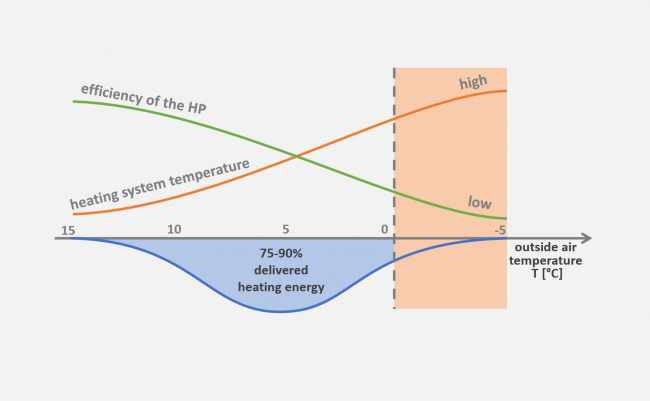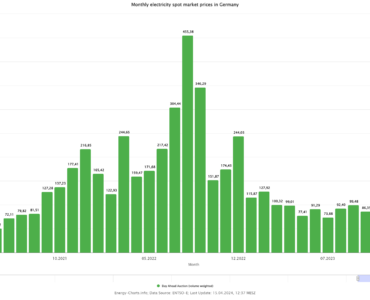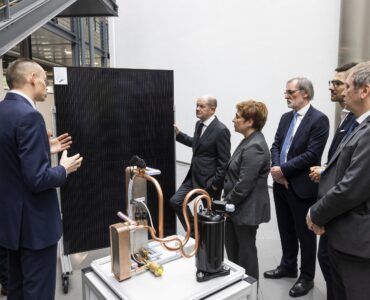Episode 2 of heat pumps in existing buildings: Why the maximum required temperature is not the decisive factor
When discussing the possible use of heat pumps in existing buildings, the main counter-argument is the very high temperature of the heating circuit on which they are based. The argument is that this temperature would lead to poor efficiency of the heat pumps and would therefore be a criterion for excluding the use of heat pumps.
There are two issues to be considered here. First, can heat pumps actually deliver the flow temperatures required for existing buildings? And secondly: How high are the flow temperatures actually needed under real-life conditions?
A detailed answer to the first question depends on many aspects – such as the type of refrigerant or the compressor. As a general rule, it can be said that standard heat pumps can reach a flow temperature of 55° to 60°C without any problems. This is a rather conservative approximate value. So-called “high-temperature heat pumps” for use in residential buildings can achieve about 65° to 70°C (in industry and commerce, on the other hand, this term is reserved for heat pumps that reach over 100°C). There are also units available on the market that can reach 75°C – examples include heat pumps using propane, a natural refrigerant. The first question can therefore be answered positively: today’s heat pumps alone (without the additional direct electric heater) are capable of reaching the generally required temperature levels.
Findings from an extensive field monitoring of heat pumps in existing buildings (detached and semi-detached houses) carried out at Fraunhofer ISE have shown that, among other things, the average efficiency achieved by the devices is relatively high. At first glance, it may even appear surprisingly high to some.
During the evaluation of the measurement data, another surprise emerged: the relatively low median flow temperatures. After deeper analysis, we also came across the – often considered necessary – high flow temperatures. And only on the coldest days and only for some heat pump systems. However, these days were so rare that they had little impact on the overall efficiency of the systems. Even in unrenovated residential buildings with old radiators, heat pumps had to achieve a flow temperature of only about 55°C to provide comfortable space heating.

The described phenomenon can be explained with the help of this graph. In principle, the lower the outdoor temperature (the horizontal axis) the higher the heating circuit temperature (orange line) and the lower the efficiency of the heat pump (green line). Decisive for the average (annual) efficiency is when (at which temperatures) most of the heat was provided (blue area). 75-90% of the required heating is provided at moderate outdoor temperatures. Here, the required supply temperatures are not very high, resulting in good efficiencies.
To summarize, two conclusions can be drawn. First, heat pumps are also capable of providing high heating circuit temperatures – necessary on very cold days. And second, it is not the maximum heating circuit temperatures at all, but the average heating circuit temperatures that are decisive for the overall efficiency. This means that heat pumps can provide the required heat with satisfactory efficiency even in existing buildings.
The findings described above are confirmed by a field study from Switzerland. In this study, too, heat pumps were analyzed, among other places, in existing buildings. Very similar to the study of Fraunhofer ISE, the maximum heating circuit temperatures in the investigated heat pumps with radiators were around 55°C. The central statement of the authors of the University of Applied Sciences of Eastern Switzerland is: “Heat pumps can efficiently replace fossil heating systems even in existing buildings if properly planned, installed and commissioned”.
The next installment in our series will address the following questions: Does a home need to be renovated first for a heat pump to be installed? Can heat pumps provide comfortable space heating in existing buildings? What happens if the building is refurbished after the heat pump is installed?
Further reading:
Overview on the range of applications for heat pumps.
Episode 3 of this series: Does a house have to be renovated first in order to install a heat pump?
Project reports:
Günther et al, Fraunhofer ISE (2020) Heat pumps in existing buildings: results from the research project “WPsmart im Bestand”. https://www.ise.fraunhofer.de/content/dam/ise/de/downloads/pdf/Forschungsprojekte/BMWi-03ET1272A-WPsmart_im_Bestand-Schlussbericht.pdf
Prinzing et al, OST – Ostschweizer Fachhochschule 2020: report “Field measurements of heat pump systems heating season 2019/20”. https://www.ost.ch/fileadmin/dateiliste/3_forschung_dienstleistung/institute/ies/wpz/sonstige_wichtige_dokumente/2020_jahresbericht_feldmessungen.pdf
Header picture: Pixabay
This blog post is financially supported by the Climate Neutrality Foundation.





Heat Pumps in existing buildings? Best to do an analysis based on something like:
1. Reduction of the load – Improve insulation, look at air change rates
2. Identify if the emitter size can be increased
3. Ground or air source – ground gives stable LT, air temps are low at high demand times and also cause frosting.
4 consider back-up direct heating for exceptionally low ambient temps and DHW.
5. Is it possible to run most hours at off peak periods and utilise buffering/phase change storage? ……….
Install key measurement sensors that can provide data for analysis
What is the payback/carbon objective? Its only by looking at these points closely that unwelcome surprises are avoided.